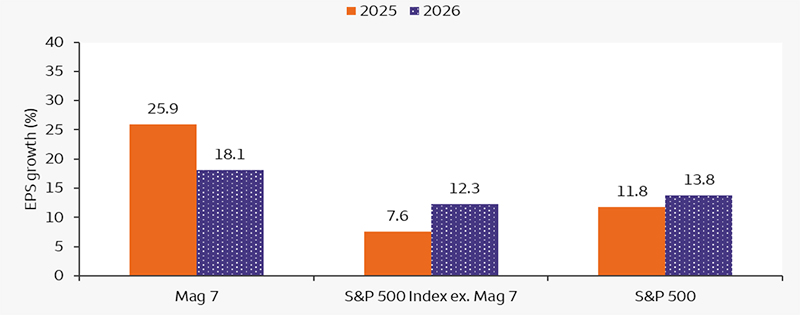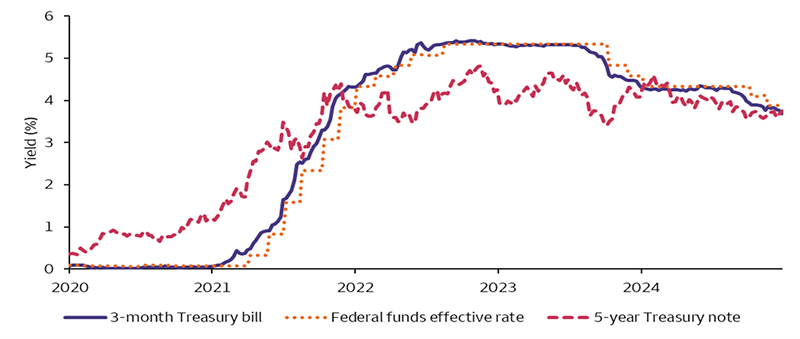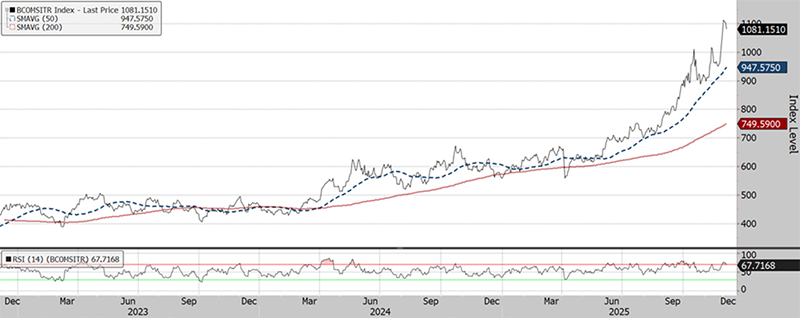Despite headlines, equity-market breadth is improving
Since the rapid acceleration of the AI theme a few years ago, investors have been concerned about the narrowing equity-market breadth — a select group of stocks have been the main drivers of equity-market performance and earnings over the last several years, which we believe has started to turn — and its implication for overall market performance going forward. This is understandable for a number of reasons:
- Market concentration:
- The world’s largest company and AI bellwether has a market capitalization higher than the Energy, Materials, and Real Estate sectors combined (in addition to the Utilities sector as of this writing).
- The Magnificent 7 (Mag 7; a group of 7 stocks (Tesla, Apple, Microsoft, Alphabet, Meta, Amazon, and Nvidia) weighting reached an all-time high of 36% of the S&P 500 Index in November.
- As of November 30, the S&P 500 Information Technology sector accounts for 34% of the S&P 500 Index market-cap weight — slightly higher than its share at the peak of the dot-com bubble in 2000.
- Earnings concentration:
The two dominant sectors related to the AI theme (Information Technology and Communication Services) have accounted for 27.4% and 10.6% of S&P 500 earnings to date this year through November 30. According to Ned Davis Research, they are projected to account for 21.3% and 9.5% in 2026, respectively.
- Performance. Since ChatGPT was released on November 30, 2022, the three-year total return through November 30, 2025 for AI-related stocks has dominated that of the benchmark S&P 500 Index:
Largest AI stock 946%
Mag 7 275%
S&P 500 Information Technology sector 146%
S&P 500 Index 74%
We believe the S&P 500 Index could be on the verge of advancing 20-plus percent for three consecutive calendar years, driven primarily by a select group of mega-tech stocks tied to the AI theme. A major equity rally built on narrow participation, or breadth, can be more subject to a significant pullback. This happened in early and mid-2024, when heavily capitalized Mag 7 stocks corrected, dragging major stock indexes lower.
When breadth has increased in the S&P 500 Index and the market rallied, it historically has indicated underlying strength. When breadth has decreased while the market rallied, it historically has tended to indicate some internal weakness, suggesting markets may be more vulnerable to a downturn. Of course, past performance is not a guarantee of future results.
Our perspective
Although the AI theme and accompanying narrow market breadth of the S&P 500 Index have dominated the financial headlines, we see signs that equity-market breadth is widening, which we believe should translate to a healthier environment for stocks in 2026. Here are six indicators that tell us that breadth is expanding:
- The equal-weighted S&P 500 Index, Russell 1000 Value Index, and Russell 2000 Index are currently near all-time highs.
- According to Piper Sandler, the percentage of stocks outperforming the market-cap weighted S&P 500 Index based on calendar-year returns has steadily increased from less than 30% in 2023 to approximately 40% quarter-to-date through December 9.
- Since midyear, the percentage of S&P 500 stocks above their 50-day moving average (an indication that prices are trending higher) has been steadily rising — currently at 55% (as of December 5, per Bloomberg) versus a low of 32% on November 20, 2025.
- Price/earnings multiples of the median S&P 500 stock have moved higher this year (12/31/24 - 11/06/2025; FactSet via Strategas), while the median multiple of the top five stocks has slightly declined.
- 9 of 11 S&P 500 sectors exceeded expectations for earnings in the third quarter, while every sector surpassed revenue expectations — in both cases by wide margins overall.1
- Just two of the Mag 7 stocks have outperformed the benchmark S&P 500 year-to-date through November 30, according to Piper Sandler.
-
Bloomberg 12-month earnings forecasts for 2026 indicate that corporate profits are set to expand beyond a select group of mega-cap tech stocks — which is a sharp departure from the bifurcation that has defined the past several years. For example, Piper Sandler projects that U.S. mid- and small-cap earnings should meaningfully accelerate, while the difference in earnings growth between the Mag 7 and the S&P 500 ex.-Mag 7 is expected to narrow (see Chart 1).
Chart 1. Earnings difference between Mag 7 and S&P 500 ex. Mag 7 expected to compress in 2026
Sources: Bloomberg and Wells Fargo Investment Institute, as of December 4, 2025. EPS = earnings per share. The Mag 7 is a group of 7 stocks (Tesla, Apple, Microsoft, Alphabet, Meta, Amazon, Nvidia). The S&P 500 ex. Mag 7 index is a market capitalization-weighted index that includes all S&P 500 companies apart from the magnificent 7 stocks. An index is unmanaged and not available for direct investment.
Past performance is no guarantee of future results.
What it means for investors
We believe unsustainably high U.S. economic growth is easing, due to delayed tariff impacts that are now lifting consumer prices, slower job creation, and repercussions from the government shutdown.
We see the slowdown as temporary and believe equity markets have already begun to move away from the headline uncertainties in anticipation of accelerating economic growth later in 2026 because of positive policy trends already in place — tax cuts that should deliver sizable refund checks, deregulation, and more Fed rate cuts. Indeed, the recent widening of equity-market breadth as it relates to overall performance and forecasted earnings growth is a sign of investors’ expectations for stronger economic growth and higher stock prices in 2026.
Bottom line: The market, as measured by the S&P 500 Index, has rallied as breadth has increased, which should be a positive sign.
1 "Looking Ahead", Wells Fargo Investment Institute. December 5, 2025.
Impacts of Fed cuts to short-term bond investor
Money market funds and ultra short-term fixed income investments have been a popular place to park capital for the past several years, making it even more attractive given political and economic uncertainty. Investors have added nearly $3 trillion to money market funds since early 2020,2 evidencing a high level of interest. However, we believe that falling interest rates have and will continue to impact the attractiveness of ultra short-term assets and that extending maturities slightly in fixed income holdings may be a better option.
Chart 2. Ultra-short yields have fallen from recent highs
Source: Bloomberg, data from December 14, 2025, to December 8, 2025. Current yields may be higher or lower than illustrated.
Past performance is no guarantee of future results.
A key aspect of the attractiveness of money market funds over the past several years came from the yields available. Chart 2 shows that as a result of the Fed’s efforts to fight inflation in 2022 and 2023, investors saw yields north of 5% in these ultra short-term investments with relatively little risk. However, Chart 2 also demonstrates that yields at this level have not been the norm in recent history. Most importantly, these yields have already come down significantly as the Fed has moved to ease rates, most recently during their December meeting.
We believe the Fed is poised to keep cutting rates, with two additional 25 basis point (bps; 100 bps equals 1%) cuts in early 2026 implied by our targets, so we believe investors should be repositioning their ultra short-term and short-term investments before rates fall further. Our view is that an effective way to do this may be slightly extending duration (a measure of interest rate sensitivity) to longer maturity investments. We are favorable on U.S. Intermediate Term Taxable Fixed Income in the three to seven year maturity range as a result, believing it to be a good mix of risk and yields while allowing investors to consider locking in current yields through expected further rate cuts.
2 FRED, St. Louis Fed, as of September 11, 2025. Money Market funds stood at $7.48T and were $4.7T in the first quarter of 2020.
Silver beginning to overheat
Silver has been a standout performer within commodities this year with the Bloomberg Silver Total Return Index (BCOMSITR) up 93.79% year-to-date, as of December 4. The main driver of this performance has been a solid global economy that has fostered demand for silver’s industrial uses, such as solar panels and electric vehicle components. Another major factor has been sticky inflation, which is expected to bottom as the Fed resumes cutting interest rates. Combined with high levels of geopolitical uncertainty and weakness in the U.S. dollar, these conditions have led central banks and retail investors to further diversify their portfolios beyond stocks and bonds and into commodities, such as silver and gold.
While some of these factors — such as a stabilizing U.S. dollar — may lose strength in the coming months, we believe it is hard to see most of them reversing anytime soon. Still, we believe the recent rally has left silver quite overbought, and our view is that a breather is due. Investors may want to take profits and wait for a pullback to add exposure to silver and our favorable-rated precious metals sector.
Chart 3 below shows the BCOMSITR Index (1081) is in an uptrend, with the 50-day moving average (948) now trading above the 200-day moving average (750). Key support levels are expected at the 50-day moving average (948,) followed by the 200-day moving average (750). The Relative Strength Index (RSI) in the panel below is close to overbought at a reading of 68, which we believe suggests near-term gains might be harder to come by.
Chart 3. Silver seems overdue for a breather
Sources: Bloomberg and Wells Fargo Investment Institute. Daily data from December 4, 2022, through December 4, 2025. BCOMSITR = Bloomberg Silver Total Return Index. SMAVG (50) = 50-day simple moving average. SMAVG (200) = 200-day simple moving average. RSI = relative strength index. An index is unmanaged and not available for direct investment.
Past performance is no guarantee of future results.
Infrastructure and secondaries led fundraising gains
Fundraising activity in private markets has often reflected investor sentiment and commitment to new funds. Recent data from PitchBook shows mixed trends across private asset classes as of the third quarter this year.3
Private equity continued to face headwinds, with fundraising pressured by persistent exit backlogs. If current trends continue, venture capital in particular will likely record its third consecutive year of fundraising declines in 2025 (see Chart 4). Longer fundraising timelines underscore these challenges — the median time to close fundraising for venture capital has reached a record 17.4 months, up from 10.3 months in 2022.3 In contrast, growth equity, which targets more established businesses, has demonstrated resilience (see Chart 4).
Private-debt fundraising has also slowed after years of rapid expansion. While direct lending remains popular, investors have increasingly diversified into specialty strategies such as distressed credit, mezzanine financing, and private-debt secondaries.3 As shown in Chart 4, private real estate fundraising shows signs of stabilization, though commitments in 2025 remain well below historical averages.
Conversely, the chart illustrates that secondaries and private infrastructure continued to attract strong demand. Fundraising for both strategies in the first three quarters of 2025 surpassed full-year totals for 2023 and 2024.3 We recently initiated coverage on Private Equity – Secondaries and Private Infrastructure with favorable guidance, given our expectation of continued structural tailwinds including long-term capital needs, AI adoption, and differentiated risk-return profiles.
Looking ahead, we believe the expectations for lower borrowing costs, improved public-market clarity, as well as recovering deal activity in 2026 should support private markets. However, for now, we remain focused on high-quality and defensive sub-strategies, including Private Equity – Growth Equity, Private Equity – Secondaries, and Private Infrastructure.
Chart 4. Private infrastructure and secondaries have led fundraising growth in 2025, whereas venture capital and buyout strategies have slowed year over year
Sources: Pitchbook and Wells Fargo Investment Institute. Data as of September 30, 2025. Year-over-year growth is calculated using the data from the first three quarters this year compared to the same period last year. The chart is based on data collected by Pitchbook. No index is used.
Past performance is no guarantee of future results.
Alternative investments, such as hedge funds, private equity, private debt and private real estate funds are not appropriate for all investors and are only open to “accredited” or “qualified” investors within the meaning of U.S. securities laws.
3 Pitchbook, “Global Private Market Fundraising Report,” November 26, 2025.
Cash Alternatives and Fixed Income
intentionally blank
intentionally blank
intentionally blank
| Most Unfavorable |
Unfavorable |
Neutral |
Favorable |
Most Favorable |
|
intentionally blank
|
- U.S. Long Term Taxable Fixed Income
- U.S. Short Term Taxable Fixed Income
|
- Cash Alternatives
- Developed Market Ex-U.S. Fixed Income
- Emerging Market Fixed Income
- High Yield Taxable Fixed Income
|
- U.S. Intermediate Term Taxable Fixed Income
|
intentionally blank
|
Equities
| Most Unfavorable |
Unfavorable |
Neutral |
Favorable |
Most Favorable |
|
intentionally blank
|
|
- Developed Market Ex-U.S. Equities
- Emerging Market Equities
|
- U.S. Large Cap Equities
- U.S. Mid Cap Equities
|
intentionally blank
|
Real Assets
| Most Unfavorable |
Unfavorable |
Neutral |
Favorable |
Most Favorable |
|
intentionally blank
|
intentionally blank
|
- Commodities
- Private Real Estate
|
|
intentionally blank
|
Alternative Investments**
| Most Unfavorable |
Unfavorable |
Neutral |
Favorable |
Most Favorable |
|
intentionally blank
|
intentionally blank
|
- Hedge Funds—Equity Hedge
- Hedge Funds—Macro
- Hedge Funds—Relative Value
- Private Equity
- Private Debt
|
|
intentionally blank
|
Source: Wells Fargo Investment Institute, December 15, 2025.
*Tactical horizon is 6-18 months
**Alternative investments are not appropriate for all investors. They are speculative and involve a high degree of risk that is appropriate only for those investors who have the financial sophistication and expertise to evaluate the merits and risks of an investment in a fund and for which the fund does not represent a complete investment program. Please see end of report for important definitions and disclosures.



 Sources: Bloomberg and Wells Fargo Investment Institute, as of December 4, 2025. EPS = earnings per share. The Mag 7 is a group of 7 stocks (Tesla, Apple, Microsoft, Alphabet, Meta, Amazon, Nvidia). The S&P 500 ex. Mag 7 index is a market capitalization-weighted index that includes all S&P 500 companies apart from the magnificent 7 stocks. An index is unmanaged and not available for direct investment. Past performance is no guarantee of future results.
Sources: Bloomberg and Wells Fargo Investment Institute, as of December 4, 2025. EPS = earnings per share. The Mag 7 is a group of 7 stocks (Tesla, Apple, Microsoft, Alphabet, Meta, Amazon, Nvidia). The S&P 500 ex. Mag 7 index is a market capitalization-weighted index that includes all S&P 500 companies apart from the magnificent 7 stocks. An index is unmanaged and not available for direct investment. Past performance is no guarantee of future results. Source: Bloomberg, data from December 14, 2025, to December 8, 2025. Current yields may be higher or lower than illustrated. Past performance is no guarantee of future results.
Source: Bloomberg, data from December 14, 2025, to December 8, 2025. Current yields may be higher or lower than illustrated. Past performance is no guarantee of future results. Sources: Bloomberg and Wells Fargo Investment Institute. Daily data from December 4, 2022, through December 4, 2025. BCOMSITR = Bloomberg Silver Total Return Index. SMAVG (50) = 50-day simple moving average. SMAVG (200) = 200-day simple moving average. RSI = relative strength index. An index is unmanaged and not available for direct investment. Past performance is no guarantee of future results.
Sources: Bloomberg and Wells Fargo Investment Institute. Daily data from December 4, 2022, through December 4, 2025. BCOMSITR = Bloomberg Silver Total Return Index. SMAVG (50) = 50-day simple moving average. SMAVG (200) = 200-day simple moving average. RSI = relative strength index. An index is unmanaged and not available for direct investment. Past performance is no guarantee of future results. Sources: Pitchbook and Wells Fargo Investment Institute. Data as of September 30, 2025. Year-over-year growth is calculated using the data from the first three quarters this year compared to the same period last year. The chart is based on data collected by Pitchbook. No index is used. Past performance is no guarantee of future results.
Sources: Pitchbook and Wells Fargo Investment Institute. Data as of September 30, 2025. Year-over-year growth is calculated using the data from the first three quarters this year compared to the same period last year. The chart is based on data collected by Pitchbook. No index is used. Past performance is no guarantee of future results.